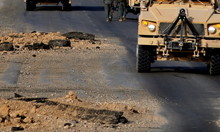Embedded Fragments
An embedded fragment is a piece of metal or other material, that stays in the body after an injury. Another common term used for this material is shrapnel. Embedded fragments are of concern because they may contain material that might be harmful.
Fragments could cause harm to the body in two different ways. First, they could cause problems (such as inflammation) at the site of the fragment. Second, toxic materials from the fragments could leach and go to other parts of the body through the bloodstream.
The Metal Exposures and Depleted Uranium (MEDU) Surveillance Center, located at the Baltimore VA, provides support to VA care providers in managing the health of post-9/11 Veterans who have fragments in their bodies after an injury.
Toxic Embedded Fragments
Shrapnel and other metals that remain in the body after a blast injury.
These fragments come from improvised explosive devices (IEDs), bombs, mines and shells. Some fragments may contain depleted uranium.
Canada, Africa, Western/Central Europe, North Asia, Southwest Asia, Southeast Asia, East Asia, South-Central Asia
Gulf War, Operation Enduring Freedom (OEF) / Operation Freedom's Sentinel (OFS), Operation Iraqi Freedom (OIF) / Operation New Dawn (OND), World War II, Korean War, Vietnam War
Although health problems caused by toxic embedded fragments are not fully understood, generally fragments are harmful in two ways:
- Injury at the site of the fragment
- Chemicals from the fragment that travel through the bloodstream and can affect other parts of the body. Metals in the body can cause high levels of toxicity in some organs.
- VA toxic embedded fragments webpage
- https://www.publichealth.va.gov/exposures/toxic_fragments/index.asp
Get a Registry Evaluation
- Environmental Health Coordinator
- https://www.publichealth.va.gov/exposures/coordinators.asp
Contact your local https://www.publichealth.va.gov/exposures/coordinators.asp or VA Primary Care Team about getting a registry evaluation.
WRIISC Link
- War Related Illness and Injury Study Center (WRIISC)
- https://www.warrelatedillness.va.gov/WARRELATEDILLNESS/referral/index.asp
For evaluation for difficult-to-diagnose conditions, contact your local https://www.warrelatedillness.va.gov/WARRELATEDILLNESS/referral/index.asp.
Toxic Embedded Fragment Surveillance Center
- https://www.publichealth.va.gov/exposures/depleted_uranium/followup_program.asp
VA offers medical surveillance for Veterans of Operation Enduring Freedom (OEF) / Operation Freedom's Sentinel (OFS), Operation Iraqi Freedom (OIF) / Operation New Dawn (OND) with embedded fragments as the result of injury received while serving in an area of conflict.
- For more information, visit: https://www.publichealth.va.gov/exposures/toxic_fragments/surv_center.asp
2001 2100 Operation Enduring Freedom (OEF) / Operation Freedom's Sentinel (OFS) Southwest Asia, South-Central Asia





















